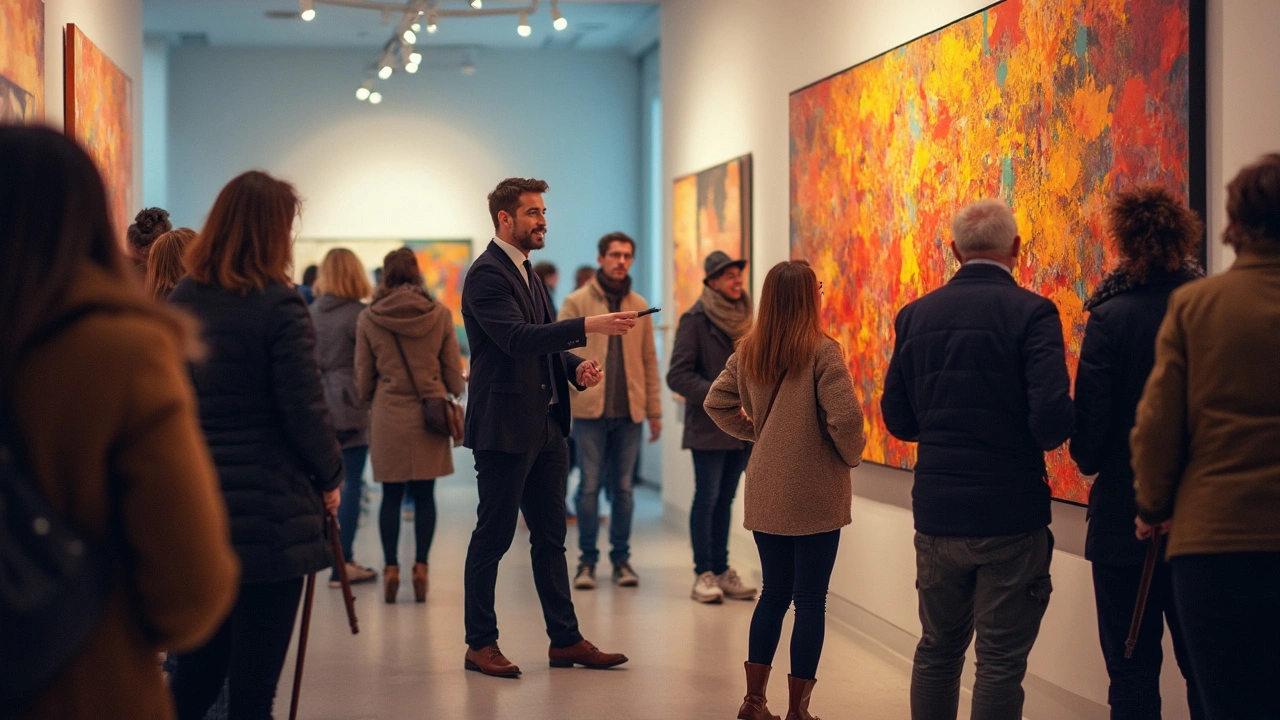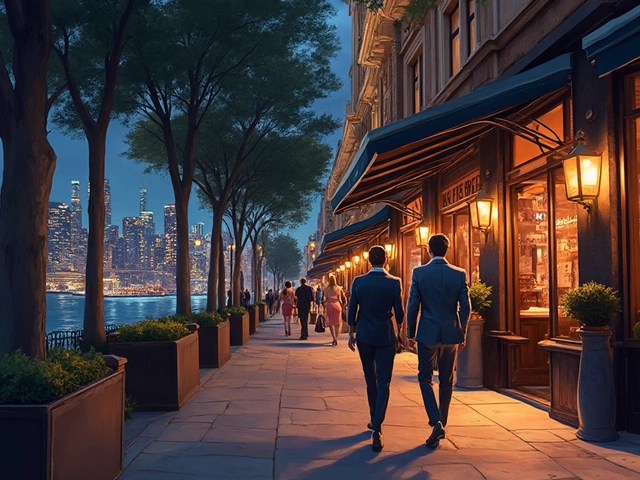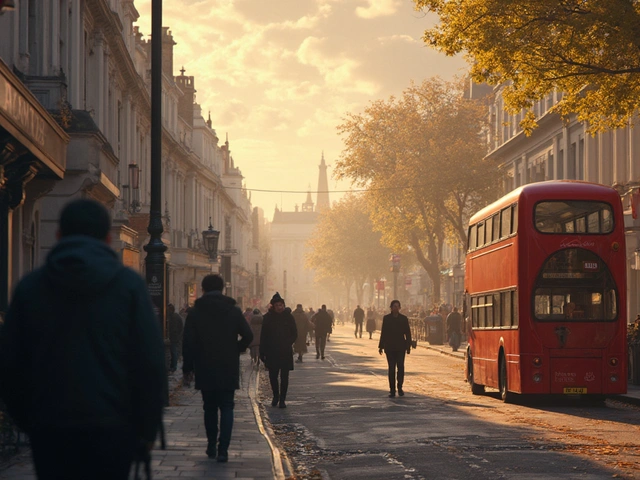The Gallery Escort: Navigating Art with Confidence

- Landon Zephyr
- 20 March 2025
- 0 Comments
Ever found yourself lost in a maze of modern art, not sure what you're really looking at? That's where a gallery escort comes in handy. These folks are like your personal art GPS, translating the artist's vision into words you can actually understand. Whether you’re a seasoned collector or just taking a casual stroll through your local art museum, a gallery escort elevates your experience from clueless wandering to insightful exploration.
So, what exactly does a gallery escort do? Think of them as your art interpreters. They're well-versed in different art styles and periods, ready to share their knowledge without a hint of snobbery. They don't just reel off facts; they engage with visitors, asking questions and sparking conversations that make you think. A good escort makes art relatable, drawing connections between what you're seeing and real-life stories or current events.
- The Role of a Gallery Escort
- Skills and Knowledge Needed
- Engaging Visitors Effectively
- Tips for Enhancing Art Experiences
The Role of a Gallery Escort
The art world can sometimes feel like a mysterious club with its own language and set of rules. A gallery escort bridges that gap, making art accessible to everyone, from novices to seasoned art lovers. They’re much more than just tour guides; they’re part educator, part storyteller, and occasionally, a bit of a performer.
At its core, the job of a gallery escort involves knowing the ins and outs of various art styles—modernism, abstraction, surrealism, you name it. They need to have a solid grasp on the history and context behind these works. But it’s not just about memorizing dates and names; it’s about weaving together facts with narratives that captivate visitors.
Besides knowledge, a gallery escort must have a knack for communication. They ought to engage people, sometimes even coaxing those who are shy or uncertain to express their thoughts. An effective escort creates an inclusive environment where every opinion is valid, and every question is worth asking. This keeps the visitors invested and transforms their visit into a memorable experience.
Another critical aspect of their role is adaptability. No two tours are alike, and they must be ready to customize their approach based on the audience's interest levels and knowledge. Whether it's a group of curious high school students or a cohort of art historians, the art guide tailors the experience accordingly.
Moreover, gallery escorts often collaborate with artists and curators to ensure their information is up-to-date and accurate. This collaboration helps them to stay on top of the latest exhibitions and thought-provoking pieces. Their proactive approach means they can answer the ever-present ‘why’ behind an artwork, which is often the most thrilling part of any exhibition.
Skills and Knowledge Needed
To be a successful gallery escort, you need a solid blend of skills and knowledge. It's not just about knowing art; it's about communicating it in a way that's engaging and approachable. Let's break it down.
First, you've got to know your art history. So, brush up on your knowledge of different art movements, key artists, and influential pieces. Understanding the backstory behind each piece helps you create a richer narrative for the visitors. Plus, being aware of the latest trends keeps your insights fresh and relevant.
Communication skills are just as vital. You need to talk art without confusing people with jargon. It’s about creating dialogue, not giving lectures. Active listening is key. Pay attention to the visitor's reactions and tailor the conversation accordingly. It’s also important to ask open-ended questions to engage visitors in a discussion.
A gallery escort should also have strong observational skills. Noticing the small details in artworks can give visitors new perspectives. It’s these little insights that turn a good tour into a memorable experience.
Being tech-savvy is increasingly important. Many galleries are incorporating tech into their exhibits, so knowing how to navigate digital installations or use audio-visual aids can greatly enhance the visitor experience. It's worth noting that a 2023 report stated that nearly 60% of galleries in major cities now utilize interactive technology in their exhibitions, making this a useful skill to acquire.
- Art History Knowledge: Styles, movements, and artists.
- Communication Skills: Effective storytelling and active listening.
- Observational Ability: Spot intriguing details for deeper engagement.
- Tech Skills: Familiarity with digital art tools and interactive displays.
Finally, be adaptable. Every visitor is different, so being flexible in your approach is crucial. One day you might be guiding a class of curious school kids; the next, it’s a group of art collectors. Adapting to their level of understanding and interests makes you an invaluable part of their art experience.

Engaging Visitors Effectively
When you're a gallery escort, keeping your audience's attention is a lot like hosting a dinner party. You want everyone to feel included and foster discussions that are lively but informative. Not sure where to start? Here are some tips for keeping those conversations as vivid as the art itself.
First off, throw out any scripted speeches. Tailoring what you say to the group you're with can make all the difference. Are they into Renaissance art or do they have a soft spot for contemporary pieces? If you've got someone who's keen on modern art, dive into how those wild brush strokes mirror today's chaotic world.
Fostering two-way communication is crucial, too. Ask questions like, “What does this piece make you feel?” or “Do you see any connections to today’s world?” These questions turn a passive walk-through into an engaging dialogue, which visitors find pretty refreshing.
"To truly make an impact, you must connect the art to the viewer’s own life," says art historian and renowned curator Dr. Emily Reed.
Play to your strengths—or your art turbo boosters—like body language and storytelling. Being enthusiastic isn't just contagious; it's magnetic. The energy you bring into the room can shape the experience your visitors have.
Don't forget to keep it simple. While it’s impressive to know that Picasso had a Blue Period, what might be even more memorable is how these pieces broke tradition at the time. Bringing art into real-life contexts is where the magic happens.
Sometimes, a little extra context can make art less daunting. Consider sharing a quick timeline or fun facts about famous artists. Check out this quick reference:
| Artist | Style | Noteworthy Period |
|---|---|---|
| Picasso | Modernism | 1901-1904 (Blue Period) |
| Van Gogh | Post-Impressionism | 1888 (Arles Period) |
Finally, remember that every visit is different. By tuning into the interests and moods of your visitors, you can craft a unique, memorable experience with every tour. So put on that metaphorical tour guide hat and connect people to the art in a way that means something to them.
Tips for Enhancing Art Experiences
Stepping into a gallery can sometimes feel a bit overwhelming, right? Fear not, because enhancing your art experience can be simpler than you think. Whether you're a budding aficionado or just tagging along with friends, here are some actionable tips to make your gallery visit more rewarding.
First and foremost, approach each piece with an open mind. Art is subjective, and that's what's so cool about it. You don’t have to ‘get it’ right away or at all. Instead, ponder how it makes you feel. Remember, a gallery escort is there to guide, not dictate your experience. If you’re not sure about something, just ask!
Next, engage actively with your surroundings. Jot down your thoughts, or even sketch if you’re up for it. This keeps your mind focused and might make you notice details you’d otherwise miss. Plus, it’s sometimes fun to compare your thoughts with the artist’s intention later on.
Another insider tip is to visit galleries when they’re quieter. Weekday mornings often have fewer crowds, allowing for a more personal viewing experience. This way, you can take your time without feeling rushed.
- Plan Your Route: Before diving into a large gallery, map out the sections you’re most interested in. This prevents burnout halfway through and ensures you see what you came for.
- Use Technology: Many galleries have apps or QR codes next to exhibits. These can offer a deeper dive into the art's history or the artist's background.
- Participate in Guided Tours: Even if you're not with a gallery escort, signing up for a guided tour can provide insights and stories you wouldn’t hear otherwise.
Consider bringing a friend along who knows a bit more than you do. A mix of perspectives can lead to a more rounded understanding and often sparks lively debate.
Lastly, take regular breaks. Art fatigue is real. Grab a coffee, chat with a stranger about what you’ve seen, then dive back in refreshed and ready to explore more.
Now, go ahead and enjoy your next art adventure. Hopefully, these tips give you a fresh perspective and help you unlock the full potential of your art navigation skills!


